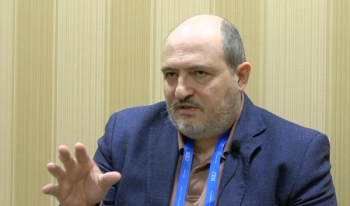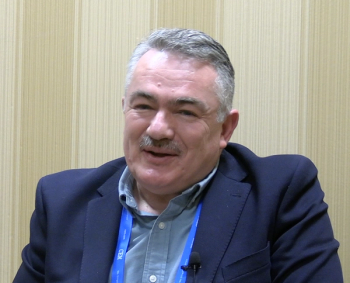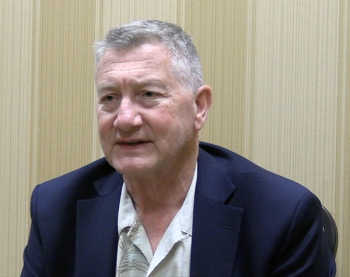
Life on Mars? Raman Spectroscopy Tests Stability of Biomolecules at Surface Conditions
Author Jean-Pierre P. de Vera talks to Spectroscopy magazine about his study in which seven biomolecules were exposed to a simulated Martian environment outside the International Space Station (ISS) for a period of approximately 15 months.
A 2022 study in the journal Science Advances piqued Spectroscopy’s curiosity with its suggestion that Raman spectroscopy would be a viable approach for the detection of biomolecules, and particularly subsurface biosignatures, on missions to Mars (1). This study paved the way for current Raman studies taking place on the Red Planet (2). Published in the journal Science Advances, the report is the collaborative work of some 37 authors, led by Mickael Baqué and Jean-Pierre P. de Vera of the Microgravity User Support Center at the German Aerospace Center in Köln, Germany.
In an email communication with Spectroscopy, de Vera discussed the study and its place within the European Space Agency (ESA)’s BIOMEX (BIOlogy and Mars EXperiment) project, as well as other programs such as ESA’s ExoMars and National Aeronautics and Space Administration (NASA)’s Mars 2020 mission, launched from Cape Canaveral, Florida, USA. He said selected biomolecules showed promise of being picked up by Raman instruments on these or other future rovers, “Some chosen biomolecules and particularly some pigments are resistant to the conditions in space and detectable by Raman spectroscopy if embedded in Mars-like regolith/mineral mixtures in a Mars-like atmosphere and Mars-like surface irradiation,” de Vera said.
How the research team arrived at that conclusion was as part of the near-700-day BIOMEX mission from July 2014 to June 2016, during which four experiments testing the feasibility of Raman spectroscopy were conducted outside the International Space Station (ISS) for a period of 469 days (1). In preparation, seven biomolecules – β-carotene, cellulous, chitin, chlorophyllin, melanin, naringenin, and quercetin–were mixed with two Martian regolith analogs. According to the study, while a regolith surrounding a potential molecule may offer protection and stabilization, it may increase the Raman signal background level, which decreases signal-to-noise ratio (S/N) and accordingly, chances of detection.
The group of biomolecules was first exposed to simulated Mars conditions in low Earth orbit (LEO), as amino acids and DNA had been in previous analysis–although not by Raman spectroscopy (1). But the researchers said that critical factors of the Martian environment, including photonic and ionic radiation, could not be simulated with high fidelity on Earth, leading to the four experiments on ESA’s EXPOSE-R2 platform.
Looking back at this process, de Vera explained his team’s hypothesis, “With the main goal to search for extinct or extant life on Mars, the selected biomolecules within the BIOMEX project are resistant to Mars-like conditions and particularly to Mars near-surface and subsurface conditions and could be detectable by the chosen Raman instruments on the rovers,” he said.
UV radiation, along with ionizing radiation and oxidizing compounds, has potential to destroy detectable traces of biosignatures anywhere from the upper centimeters to meters above the Martian surface, according to the researchers (1). But this study found that while UV radiation changed Raman spectra signals strongly, only minor changes occurred when samples were exposed to a UV-shielded subsurface.
The authors suggested expanding the range of biomolecules tested in future exploration, and further recommended implementing a systemic Raman signature database, “Therefore, if life originated and started and evolved on Mars during its habitable phase in its planetary history, Raman spectroscopy is an excellent tool to detect some remnants or complete remaining biomolecules in the near subsurface of Mars,” de Vera said.
The researchers suggested expanding the range of biomolecules tested and emphasized the potential of Raman spectroscopy as a valuable tool for detecting remnants of biomolecules in the near subsurface of Mars. This work has been invaluable for providing insight into the possibility of using Raman spectroscopy to search for past or present organic life on the planet. With such insight, Raman is currently being used to search for biomolecules on the Martian surface (2).
References
(1) Baqué, M.; Backhaus, T.; de Vera, J.-P.P.; et al. Biosignature stability in space enables their use for life detection on Mars. Sci. Adv. 2022, 8 (36). DOI:
(2) Sharma, S.; Roppel, R. D.; Murphy, A. E.; et al. Diverse organic-mineral associations in Jezero crater, Mars. Nature 2023.
Newsletter
Get essential updates on the latest spectroscopy technologies, regulatory standards, and best practices—subscribe today to Spectroscopy.




